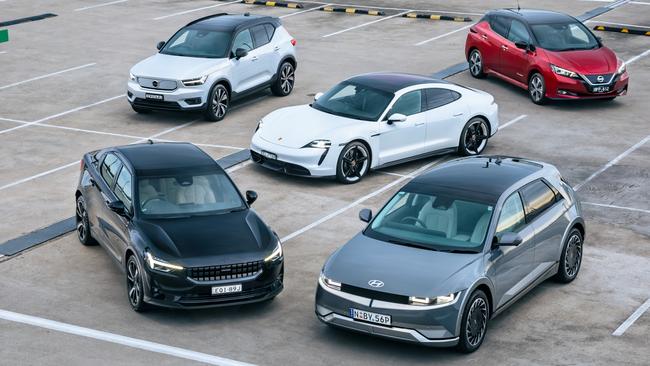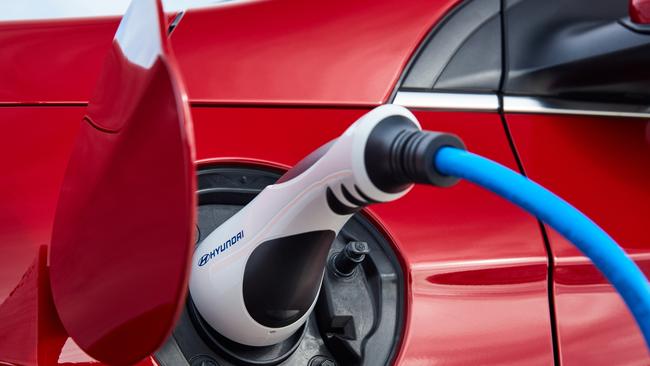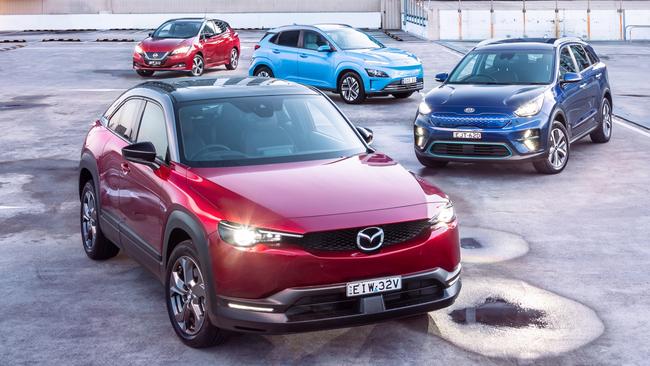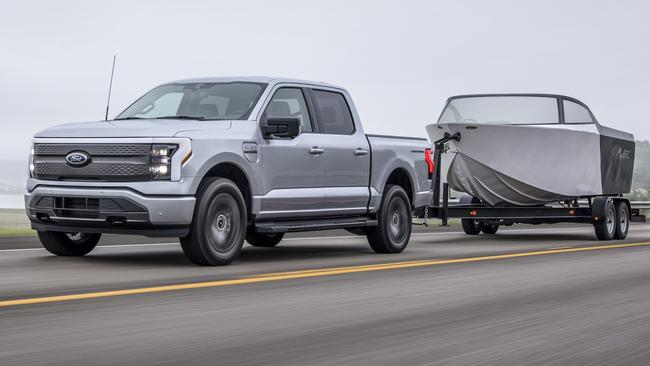Electric vehicles explained and the eight biggest myths busted
The debate about electric cars has hit fever pitch and now our motoring experts answer your questions to separate fact from fiction.
Car Advice
Don't miss out on the headlines from Car Advice. Followed categories will be added to My News.
In the past, if you wanted to get into an argument at the pub, politics, sport and religion were good ways to go about it.
Now there’s a new topic that will fire up the discussion just as quickly: electric cars.
As with all hot topics, there are a lot of myths and misconceptions.
Here are some myths and facts about electric cars.

EVS ARE NO BETTER THAN PETROL CARS FOR THE ENVIRONMENT
While EVs create more CO2 in the initial production phase, they use less over the life of the vehicle, eventually leaving a smaller carbon footprint.
Back in 2020 EV brand Polestar released a lifetime CO2 comparison between its Polestar 2 sedan and the Volvo XC40 petrol SUV produced by its parent company.
Polestar estimated that it took 24 tonnes of CO2 equivalents (CO2e) to make their EV, compared with just 14 tonnes of CO2e to make a petrol-engined XC40.
This extra CO2 is largely attributable to the production of the battery pack needed for the EV. If recharged via renewable energy only, the Polestar would need to travel roughly 50,000km before its carbon footprint became smaller than the XC40. Charged off the European grid, which is 30 per cent renewable, the Polestar would need 80,000km.
On the average global energy mix, it would take 110,000km. In Australia, roughly 24 per cent of the grid is powered by renewables.

It’s also considerably quicker off the mark than mainstream petrol SUVs. Ultimately, buyers decide whether a car is too expensive and on that score, EVs appear to be priced appropriately for the technology they deliver. Tesla’s $75,000 Model Y was the country’s number one selling SUV last month, while the Model 3 was the best-selling sedan. People seem to be willing to pay more for an EV in the same way they’ll pay more for a luxury badge. If you have a company car or novated lease, EVs are about to become a lot more affordable, thanks to a proposed FBT exemption currently passing through the Senate. Deloitte estimates the changes could make some EVs cheaper to lease than petrol cars.
EVS ARE TOO EXPENSIVE
The cheapest EVs available are the MG ZS EV and the BYD Atto, which both cost about $45,000 drive-away. EVs from mainstream brands including Kia and Hyundai start at more than $70,000 on the road, so they are expensive compared with petrol cars.

Hyundai’s Kona EV starts at $57,400 drive-away, about $22,000 more than the equivalent petrol version. But the Kona isn’t a purpose-built EV – they simply pull out the engine, fuel tank and exhaust system and replace them with batteries and a motor.
The Ioniq 5, News Corporation’s 2021 Car of the Year, is built from the ground up as an EV, which means the cabin layout is much better. It looks the size of an overgrown hatchback but the distance between its front and rear wheels – which dictates leg room – is the same as a Range Rover, which means you are getting a lot more car for your money.
ELECTRIC VEHICLES ARE FIRE-PRONE
A study by a leading US insurance company found that EVs are far less likely to catch fire than petrol and hybrid vehicles. Analysing data from the National Transportation Safety Board, AutoinsuranceEZ found that 25 out of every 100,000 EVs sold caught fire, compared with 3474 fires out of 100,000 for hybrids and 1529 for petrol and diesel cars.
Experts questioned the findings, though, arguing that the EV sample size was much smaller than that for hybrid and petrol vehicles, adding that one extra EV fire could change the statistics dramatically.
One thing the experts do agree on is that once they’ve started, EV fires are much harder to put out. Austin Fire Department in the United States estimates that an EV can take up to 150,000 litres of water to put out, compared with between 1900 and 3800 litres for a petrol car.

EVS TAKE FOREVER TO RECHARGE
There’s no argument that electric vehicles take longer to charge than a petrol vehicle takes to refuel.
But according to a survey by respected US research firm JD Power, 80 per cent of EV recharging is done at home, which is arguably less hassle – and cheaper – than visiting a petrol station.
If you use a 50kW public charger, it can take between 45 minutes and an hour to recharge the average EV, but some newer EVs offer faster charging times when hooked up to 350kW chargers.
Hyundai’s Ioniq 5 and Kia’s EV6 can charge from 10 to 80 per cent in less than 20 minutes.
After that, the charging rate slows down to stop the batteries from overheating.

BATTERIES ARE TOO EXPENSIVE AND DON’T LAST
EV batteries are expensive and their longevity is unknown. We contacted 10 EV manufacturers and only three would give us a price estimate for a battery replacement. The battery in Lexus’s UX costs almost $50,000 to replace, more than half the price of the car. But most manufacturers guarantee their batteries for eight years – some for 10. If the capacity drops below 30 per cent in that time, they’ll replace it free of charge. Experts predict that the cost of making batteries should drop by roughly a third by 2030, when today’s EVs will run out of warranty.
Tesla claims its battery packs lose just 10 per cent of their capacity in 320,000km. Based on the average mileage of 15,000km a year, that’s more than 20 years.
But the fact remains, you’re only covered for eight.

EVS DON’T HAVE ENOUGH RANGE
That depends on what you plan to use them for. The average round-trip commute in Australia is 26km a day and the range of Hyundai’s Ioniq 5 is roughly 480km.
We drove a Nissan Leaf for three months and only needed to recharge it once a week.
Longer distances are more problematic and the current crop of EVs aren’t suitable for people who drive big kilometres regularly.
EVs are less efficient on the freeway, while petrol and diesel cars are more efficient. So the 480km of range you might get in the city is likely to drop below 400km on the freeway.

THERE AREN’T ENOUGH CHARGING STATIONS
There are about 300 public fast-charging stations around Australia, with a commitment to build another 700 over the next five years. At the moment the east coast of Australia is reasonably well served but inland and more remote areas have sparse coverage. Based on our experience, public charging on the city outskirts can be a long and painful process, especially if there are other EVs already charging.

EVS CAN’T TOW
Most EVs can’t tow as much as their petrol and diesel counterparts. Ford’s F150 Lightning is an exception.
It can tow 4500kg compared to 3500kg for a Toyota HiLux. Problem is, it can’t do it for long.
Towing a big caravan typically cuts range in half for both diesel and electric vehicles. The difference is you have more range to play with if you’ve got a diesel vehicle. So while you might get 500km of range from your Toyota HiLux, the F150 would be more like 200km.
THEY DON’T BUILD AN ELECTRIC UTE
Deputy Liberal leader Sussan Ley told Sky News “no one in the world is making an electric ute”. That’s not true. Ford is having huge success with its F150 Lightning. They expected to sell 40,000 in the first year and had to close their order books after 220,000 people signed up. Chinese brand LDV also has an electric ute and plans to launch it here next month.
More Coverage
Originally published as Electric vehicles explained and the eight biggest myths busted





